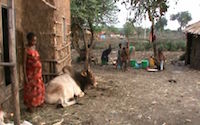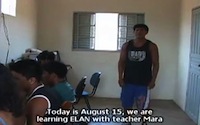This project investigates the encoding of events involving three participants in human language. It draws on data from eight DoBeS corpora and on the expertise of the associated researchers. The project brings together three areas of study: the encoding of three-participant events, the typological parameter of basic valence orientation, and the field of text-based typology.
Languages and participating researchers:
- Beaver – Dagmar Jung, Meytal Sandler
- Bora – Frank Seifart
- Movima – Katharina Haude
- Saliba-Logea – Anna Margetts
- Savasavo – Claudia Wegener
- Totoli – Nikolaus Himmelmann, Sonja Riesberg
- Vera’a – Stefan Schnell
- Waima’a – John Hajek, Nikolaus Himmelmann
Phenomena related to valence and transitivity continue to be investigated in the linguistic literature, and in recent years the related topic of three-participant events has received growing attention. Such events include any scenario involving three participants, e.g. those encoded by transactional verbs like ‘give’ and ‘show’, placement verbs like ‘put’, and benefactive constructions like ‘do something for someone’. There is considerable variation cross-linguistically as well as within individual languages in how the three involved participants are encoded.
Earlier work on three-participant events tends to focus on syntactic three-place predicates, i.e. constructions with three syntactic arguments. Some of the more recent studies, such as Margetts and Austin (2007), investigate a fuller range of linguistic strategies for encoding such events, including three-place predicates and their subtypes but also a range of functional alternative constructions many of which are syntactically two-place but express a third participant by other means – morphological, syntactic or pragmatic. (Examples of alternative strategies include, e.g. clauses with two-place predicates which encode a recipient by means of directional markers, or a beneficiary by means of possessive morphology.)
While the topic continues to attract attention, virtually all studies to date have either focussed on discovering cross-linguistic tendencies by drawing on grammars; or by investigating data from individual languages, often paying particular attention to specific constructions. These approaches have shed light on the inventory of encoding strategies found in individual languages and cross-linguistically. They have also begun to uncover the range of morpho-syntactic strategies available for certain event types (e.g. ‘give’). Such approaches have made a considerable contribution to our understanding of the function and emergence of specific encoding strategies for three-participant events, and their semantic and morpho-syntactic restrictions.
However, certain questions have remained unanswered as neither of the mentioned approaches is suitable to address (a) questions relating to the actual frequency of different encoding strategies in a language, and (b) questions about possible correlations between event types and the strategies by which they are most commonly encoded, in individual languages and cross-linguistically. To investigate these issues, text data are required and, ideally, comparable text data across a number of languages, as found in the DoBeS archive.
The project brings together researchers with expertise not only in the sample languages and in working with oral text corpora but in the field of linguistic typology, the study of three-participant events and the area of valence and transitivity.
The project is grounded in the previous research and it investigates three-participant events from a cross-linguistic and text-based perspective. It addresses two sets of topics:
- Are there correlations between semantic event types and specific morpho-syntactic encoding strategies?
- What strategies for encoding three-participant events exist in the sample languages and what is their relative frequency?
- Is there a tendency for certain strategies to co-occur in a language and is it possible to identify language types on this basis?
- Is it possible to formulate any implicational hierarchies?
- Can the morpho-syntactic strategies listed in Margetts and Austin (2007) be extended by further types or sub-types?
The overview of target events considered in this project can be found here:
Margetts, Anna, Katharina Haude, Nikolaus Himmelmann, Dagmar Jung, Frank Seifart, Sonja Riesberg, Stefan Schnell, Claudia Wegener. Three-participant events project – Encoding Strategies. (Version February 2019)
The updated list of encoding strategies considered in this project is presented here:
Margetts, Anna, Katharina Haude, Nikolaus Himmelmann, Dagmar Jung, Frank Seifart, Sonja Riesberg, Stefan Schnell, Claudia Wegener. Three-participant events project – Target events. (Version July 2019)
- Possible correlations between tendencies in the encoding of three-participant events and the classification of languages in terms of basic valence orientation, in the sense of Nichols et al. (2004):
- Are there any correlations between a language’s classification in terms of its basic valence orientation (as transitivising or detransitivising, etc.), and the set of strategies which the language has or most commonly employs for the expression of three-participant events?
By investigating both three-participant events and the parameter of basic valence orientation the project brings together two independent areas of study which are important in their own right and which have not been previously researched in relation to each other. If typological parameters like basic valence orientation and choice of encoding strategies for three-participant events can be shown to be connected and form a network of interrelated features this would open a new field of investigation in terms of lexical and grammatical expressions of valence and strengthen the parameters’ scientific importance, typological value and scope. The project applies methodologies of text-based typology to the study of three-participant events and basic valence orientation which allows us to address questions which could not be answered by earlier approaches.
References
Margetts, Anna & Austin, Peter. 2007. Three-Participant Events in the Languages of the World: Towards a Crosslinguistic Typology, Linguistics, vol. 45, no. 3: 393-451.
Nichols, Johanna, David A. Peterson & Jonathan Barnes. 2004. Transitivizing and detransitivizing languages. Linguistic Typology 8(2). 149–211.







